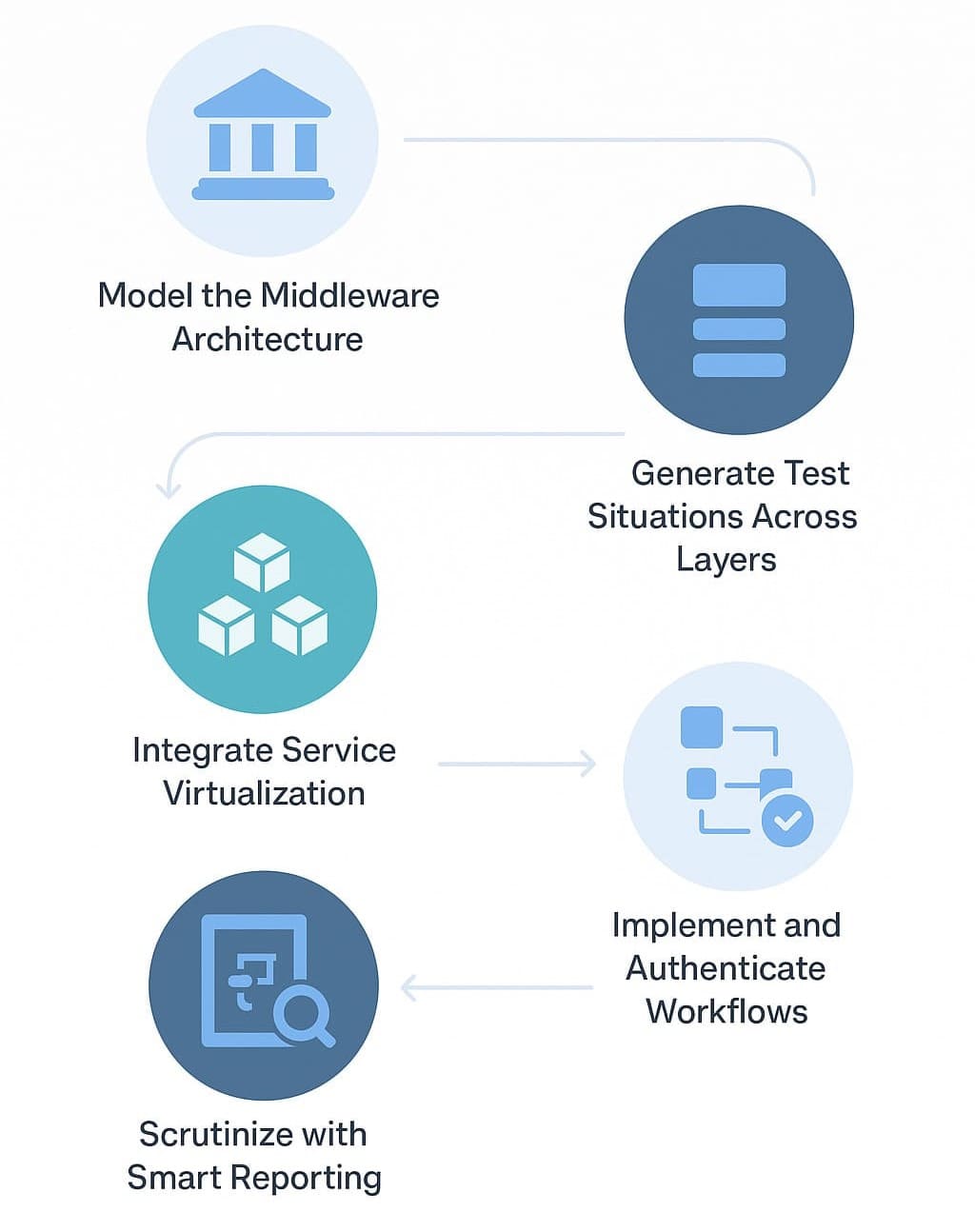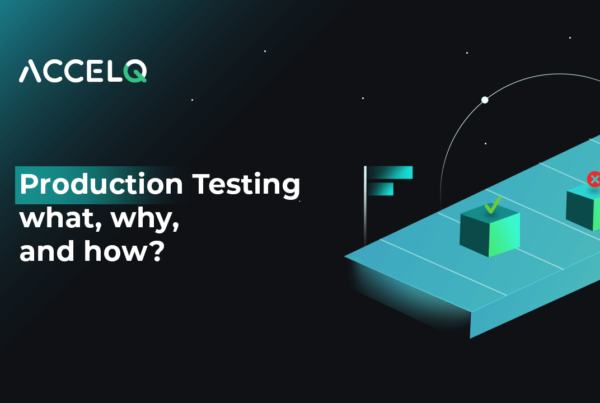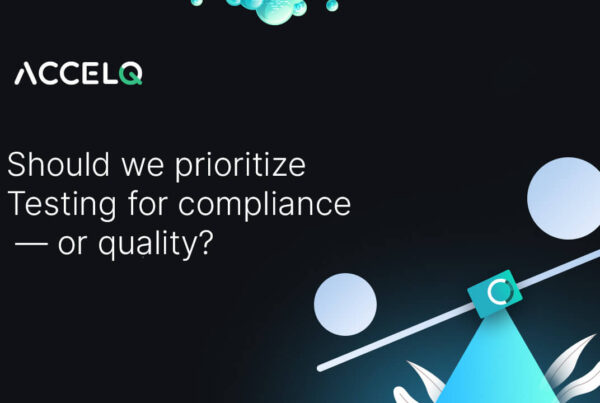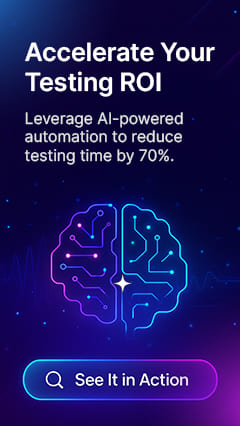End-to-End Middleware Test Automation Using ACCELQ

In interconnected enterprise situations, middleware plays a pivotal role in allowing communication between databases, disparate systems, and services. Testing such invisible yet critical layers is often intricate, overlooked, and time-consuming, resulting in undetected integration problems that surface only in production.
That’s where ACCELQ’s middleware test automation really shines. As a no-code, cloud-native automated testing platform, it empowers QA specialists to effectively test APIs, middleware logic, data flow, and message queues without human intervention or extensive scripting. In this blog, we will explore how ACCELQ enables true end-to-end middleware test automation, thereby enhancing both test coverage and launch confidence in integration-heavy systems.
What is Middleware in a Testing Context?
Middleware denotes the software layer that acts as a bridge between databases, apps, and services, managing communication, authentication, data exchange, and more. In a testing arena, middleware is not the backend database or the user-facing interface; it is the glue that ties them.
Middleware can comprise:
- Enterprise Service Buses (ESBs).
- Message brokers (for instance, RabbitMQ, Kafka).
- Integration platforms (for instance, IBM Integration Bus, MuleSoft).
- API gateways.
Testing middleware includes validating:
- Message integrity & schema compliance.
- Data transformation between systems.
- Exception handling and response time.
- Orchestration logic across solutions.
Outdated automated testing tools often fall short in this space because of the middleware’s non-UI, extremely robust nature. That’s why middleware test automation with ACCELQ offers a dynamic solution, providing smooth integration tests, service virtualization, and smart orchestration custom for these invisible elements.
What Does “End-to-End” Mean in Middleware Testing?
In the context of Quality Assurance, E2E testing refers to validating the complete flow of data and logic across each system’s elements, from the user interface to backend services. However, the term assumes additional meaning when referring to middleware.
Middleware is the unseen layer that connects front-end apps to back-end services. This comprises service buses, orchestration layers, message brokers, and API gateways. Testing the end-to-end middleware workflow entails methodically confirming this layer, not only that requests are received, but also that:
- Data is transformed correctly.
- The middleware layer enforces business rules.
- Messages are processed in the correct sequence.
- System responses are routed securely and appropriately.
It also includes testing message queues and service layers, which are often intricate, complex, asynchronous, and not directly visible to QA engineers. Proper end-to-end validation across APIs and middleware guarantees that both downstream and upstream systems behave properly in real-world scenarios.
How to Automate End-to-End Middleware Testing with ACCELQ?
Automating middleware testing could be complex because of the lack of a UI and the intricacy of real-world data flows. However, ACCELQ offers a great solution for middleware workflow testing, which makes it possible for QA professionals to automate complex integration scenarios in a straightforward, no-code manner.
Let us find out how you can accomplish end-to-end middleware workflow validation with ACCELQ:

1. Model the Middleware Architecture
This incredible platform allows you to visually model the system under test, mapping out queues, services, and API flows. This allows test design based on actual business procedures rather than raw endpoints.
2. Generate Test Situations Across Layers
It also supports middleware layer validation, allowing you to build test cases that span:
- Message brokers (JMS, Kafka, etc.)
- API calls (REST/ SOAP)
- Backend authentications (logs, databases)
3. Integrate Service Virtualization
For unstable systems or 3rd-party dependencies, it enables service virtualization, allowing you to replicate endpoints and retry conditions/test failures efficiently.
4. Implement and Authenticate Workflows
Automate the implementation of complicated systems, capturing both response data and requests to check end-to-end validation across middleware and APIs. Utilize assertions for data integrity, business rules, and schema validation.
5. Scrutinize with Smart Reporting
It offers real-time comprehensive logs and dashboards, aiding teams in rapidly finding problems across orchestration logic, services, and message queues.
By embracing ACCELQ middleware workflow testing, QA experts can automate even the complicated backend integration testing with ease, guaranteeing traceability, reliability, and rapid release cycles for enterprise apps.
Real-World Use Cases
To better understand the practical app of ACCELQ in enterprise settings, let us check out an example of end-to-end middleware automated testing.
Scenario: Banking Transaction Processing
In a standard banking app, a user uses the mobile app to start a transaction. This request passes through several middleware layers before hitting the core banking system. The architecture comprises:
- Message queues for asynchronous processing.
- API gateway to validate and route requests.
- Core banking solutions and database.
- Business logic layer for transaction rules.
With the ACCELQ no-code automation testing platform, expert teams automate the complete transaction flow:
- To duplicate the mobile request, start an API call.
- Scrutinize transformation and routing logic in middleware.
- Authenticate the message propagation in the queue.
- Assert end data state in backend systems.
This example of end-to-end middleware test automation reflects how ACCELQ assists in validating not just the data path but also the orchestration and integrity of the business logic included.
Key Rewards of ACCELQ for Middleware Testing
It delivers manifold benefits for businesses dealing with complicated middleware environments:
1. No-code Automation for Complicated Layers
QAs can design and implement integration flows with zero code, making middleware layer authentication accessible across expertise levels.
2. Smooth Testing Across Queues and APIs
It helps in direct validation of message queues and service layers, comprising asynchronous communications that outdated tools don’t have.
3. True End-to-End Visibility
The platform allows end-to-end middleware workflow authentication, offering clear insights across middleware, front-end, and backend layers, all in a united view.
4. Continuous Testing-Ready
Automated middleware testing in every pipeline is ensured by native CI/CD support, which improves release confidence and identifies regressions early.
5. Enterprise-Grade Reports
It also offers robust analytics, dashboards, and actionable logs that assist QA automation experts in debugging and optimizing rapidly, crucial in distributed architectures.
Whether you are authorizing a single service or orchestrating complicated flows across layers, this platform stands out as a strategic platform for dynamic middleware automated testing.
Conclusion
As businesses increasingly depend on integration-heavy systems, middleware testing has become mission-critical. Because middleware is asynchronous, logic-intensive, and invisible, outdated automation testing tools frequently fail in this area.
By enabling quick, precise, and adaptable end-to-end middleware automation testing, which covers everything from queues and APIs to backend validations and service orchestration, ACCELQ fills that gap.
With its no-code design, full-stack visibility, and real-time reporting, ACCELQ empowers expert teams to confidently authenticate even the complicated integration flows, transforming middleware testing from a bottleneck into a strategic gain.
💡 Future-Proof Your QA Automation
Explore an AI-powered platform and enterprise-level quality.
Get Started
Yuvarani Elankumaran
Technical Consultant at ACCELQ
Yuvarani Elankumaran is a highly skilled technical consultant at ACCELQ. With over a decade of experience in the field of Test Automation, Yuvarani is a seasoned professional who is well-versed in a variety of programming languages and automation frameworks.
You Might Also Like:
 Streamline Production Testing for Flawless Software Delivery
Streamline Production Testing for Flawless Software Delivery
Streamline Production Testing for Flawless Software Delivery
 Top Software Testing Conferences you must attend in 2025
Top Software Testing Conferences you must attend in 2025
Top Software Testing Conferences you must attend in 2025
 Should We Prioritize Testing for Compliance – or Quality?
Should We Prioritize Testing for Compliance – or Quality?
































